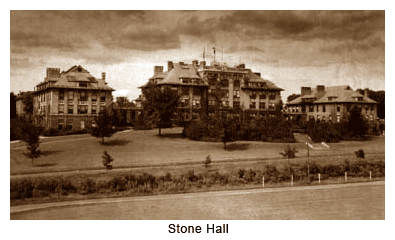.gif)
Roberts Hall (Ithaca, New York)
Encyclopedia
Roberts Hall is a building on the Ag Quad of Cornell University
, and is the second building of that name. The original Roberts Hall was built in 1906, and was listed on the U.S. National Register of Historic Places
in 1984. The 1906-built Roberts Hall was demolished before the construction of the new building and Kennedy Hall. The current building holds many of the administrative offices of the College of Agriculture and Life Sciences
and Cornell's landscape architecture
program.
 The 1906 building is still listed on the National Register, apparently erroneously as the building is no longer there. East Robert Hall
The 1906 building is still listed on the National Register, apparently erroneously as the building is no longer there. East Robert Hall
and Stone Hall
are two other former Cornell University buildings that were and are similarly listed.
In 1973, Franzen and Associates, the architechtural firm that was designing Cornell's statutory college buildings at that time, conducted a study indicating that Roberts, East Roberts, Stone, Caldwell and Comstock Halls were unsafe and should be condemned. Franzen concluded that it would cost $14 million to renovate the five buildings and that it would be cheaper to tear them down and replace them with new buildings, presumably designed by Franzen. (Ironically, as of 2010, Caldwell and Comstock Halls are still in use, but another Franzen-designed building, the north wing of Martha Van Ressensaler Hall, had to be demolished as structurally unsound.) By 1978, the cost of demolishing the five buildings and building two replacements had escallated to $18 million. In response, two groups, Historic Ithaca and a student-group called the "Ag Quad Preservation Society" applied to list the five buildings on the National Register and sought to protect them under a newly-enacted Ithaca historic preservation ordinance. Just before Historic Ithaca could gain a court injunction to stop the demolition of Roberts, East Roberts and Stone Halls, Cornell began the demolition. The State of New York renovated Caldwell and sold Comstock back to Cornell for use as a computer center.
Cornell University
Cornell University is an Ivy League university located in Ithaca, New York, United States. It is a private land-grant university, receiving annual funding from the State of New York for certain educational missions...
, and is the second building of that name. The original Roberts Hall was built in 1906, and was listed on the U.S. National Register of Historic Places
National Register of Historic Places
The National Register of Historic Places is the United States government's official list of districts, sites, buildings, structures, and objects deemed worthy of preservation...
in 1984. The 1906-built Roberts Hall was demolished before the construction of the new building and Kennedy Hall. The current building holds many of the administrative offices of the College of Agriculture and Life Sciences
Cornell University College of Agriculture and Life Sciences
The New York State College of Agriculture and Life Sciences is a statutory college at Cornell University, a private university located in Ithaca, New York...
and Cornell's landscape architecture
Landscape architecture
Landscape architecture is the design of outdoor and public spaces to achieve environmental, socio-behavioral, or aesthetic outcomes. It involves the systematic investigation of existing social, ecological, and geological conditions and processes in the landscape, and the design of interventions...
program.

East Robert Hall (Ithaca, New York)
East Roberts Hall was a building on the campus of Cornell University in Ithaca, New York. It no longer exists.It was listed on the U.S. National Register of Historic Places in 1984...
and Stone Hall
Stone Hall (Ithaca, New York)
Stone Hall was a building on the campus of Cornell University in Ithaca, New York, named after John Lemuel Stone, a CALS professor of farm practice during the early 1900s. It no longer exists....
are two other former Cornell University buildings that were and are similarly listed.
In 1973, Franzen and Associates, the architechtural firm that was designing Cornell's statutory college buildings at that time, conducted a study indicating that Roberts, East Roberts, Stone, Caldwell and Comstock Halls were unsafe and should be condemned. Franzen concluded that it would cost $14 million to renovate the five buildings and that it would be cheaper to tear them down and replace them with new buildings, presumably designed by Franzen. (Ironically, as of 2010, Caldwell and Comstock Halls are still in use, but another Franzen-designed building, the north wing of Martha Van Ressensaler Hall, had to be demolished as structurally unsound.) By 1978, the cost of demolishing the five buildings and building two replacements had escallated to $18 million. In response, two groups, Historic Ithaca and a student-group called the "Ag Quad Preservation Society" applied to list the five buildings on the National Register and sought to protect them under a newly-enacted Ithaca historic preservation ordinance. Just before Historic Ithaca could gain a court injunction to stop the demolition of Roberts, East Roberts and Stone Halls, Cornell began the demolition. The State of New York renovated Caldwell and sold Comstock back to Cornell for use as a computer center.

